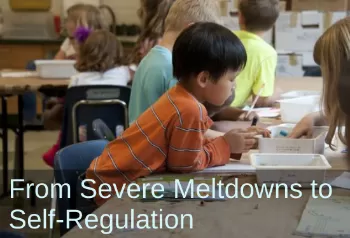Primitive Reflex Integration Case Studies
Boy with Sensory-Behavior Issues; OT Sees Huge Improvements in 8 Weeks
Neurodevelopmental movements help with emotional regulation, patience, motor skills, and participation
This OT used neurodevelopmental movements, including rhythmic movements and reflex integration, from the Brain and Sensory Foundations course to help this preschooler who had severe meltdowns become calm and able to participate in activities in a general education classroom.
Submitted by BF, Occupational Therapist

| Before | After |
|---|---|
| Unable to self-regulate | Significant improvements with self-regulation skills |
| Easily frustrated, especially when his drawings were not perfect | Can participate in a drawing activity for more than 10 min without becoming upset, even when he made a mistake |
| Would flinch and look away when a beanbag or small ball was thrown in his direction, even when given verbal prompts in anticipation | Able to catch a beanbag thrown to him without flinching or looking away |
| Often became aggressive—throwing objects, crying, kicking, hitting the wall, cursing, etc. when something did not go his way | Can engage in turn-taking games without becoming upset, even when things do not go his way |
| Required a 1:1 aide and was removed from general education class | Spending more time in his general education classroom |
Bryan is a 5-year-old little boy who was referred for an OT evaluation because of difficulties with transitions, aggression, and significant emotional responses/outbursts in school and at home. His “melt-downs” have become so severe in school, that he has required a 1:1 aide and has been removed from his general education class. Bryan presents with significant sensory processing and self-regulation difficulties. He appears to have a lot of anxiety. Bryan is easily frustrated, especially when his drawings are not perfect. He is quick to “fly off the handle” as mom puts it, and often becomes aggressive, throwing objects, crying, kicking, hitting the wall, cursing, etc. when something does not go his way. Bryan also presents with tactile sensitivities.
Due to his extreme anxiety and difficulty with transitions, I started with the rhythmic movements (RM) [from the Brain and Sensory Foundations course] right away during our sessions. I noticed Bryan relaxed and he requested that I continue the rocking several times during that first session. When first attempted, Bryan was unable to actively continue any of the movements. After a few sessions, once he appeared to be able to handle it, I decided to focus on the FPR and Moro reflex, since those seemed to be the reflexes that may have been causing so many of his difficulties. Both reflexes were retained. Bryan flinched and looked away every time a beanbag or small ball was thrown in his direction, even when given verbal prompts in anticipation. He startled with clapping and pulled away from handshakes. He kept his eyes open and squirmed each time he was touched with FPR [Fear Paralysis Reflex] stimulation. We perform a lot of monkey hugs and he loves doing the roly poly/big star during our sessions. We even added doing them in a body sock for more proprioceptive input. Bryan was able to complete a hook-up and held it briefly, but I did not observe any noticeable change. During a recent session, we attempted the 5-step balance process, which was very difficult for him. I plan to break it down and teach him the support re-patterning sequence step by step as I feel this will be very beneficial for him.
Since starting the RM and Moro/FPR integration activities [from the Brain and Sensory Foundations course] about 6-8 weeks ago, some exciting changes have taken place. Bryan has been able to participate in a drawing activity for more than 10 min without becoming upset, even when he made a mistake! He is also now able to catch a beanbag thrown to him without flinching or looking away! He was able to engage in a turn take game with a peer without becoming upset, even when things did not go his way. Bryan is showing significant improvements with his self-regulation skills. His mom reports that he has been spending more time in his general education classroom! Bryan is now able to actively continue all four RMs for short periods and is getting much more rhythmic with his movements. He is even allowing me to sing songs during the movements. Previously, he would only tolerate rhythmic counting. As we progress, I plan to address hand reflexes to assist with tactile and fine motor issues and work on his ability to complete the support re-patterning sequence and the 5-step balance process [from the Brain and Sensory Foundations course].
As a result of my experience with this client, I have seen that the RM and reflex integration activities can have a significant impact in a very short amount of time! I had not realized how the Moro reflex affected catching a ball and I have definitely changed my approach with this client and others as a result. Thank you!
(Edited, emphasis added)
*Disclaimer: The activities in the Brain and Sensory Foundations curriculum make use of the natural processes of neuroplasticity and development that are innately wired in the design of human beings to promote maturity and function. These activities appear to calm, organize, and mature the neuro-sensory-motor systems just as we see in the healthy development of human infants. Individual results may vary, and we do not claim to offer a diagnosis or cure for any specific condition or disorder. The Brain and Sensory Foundations activities appear to improve overall functioning resulting in measurable improvements for a range of conditions as demonstrated in over 1800 case studies from participants.

